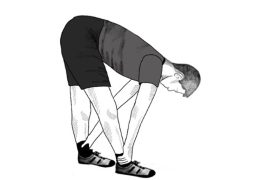Neck pain often arises from factors like poor posture, extended periods at a desk, or stress. Yoga offers effective techniques to alleviate this discomfort and enhance neck mobility. Practices such as gentle stretches, neck rotations, and specific yoga poses like Cat-Cow, Child’s Pose, and Neck Rolls can help release tension, improve flexibility, and strengthen supporting muscles. Additionally, mindful breathing and relaxation techniques practiced in yoga can reduce stress contributing to neck pain. Regular yoga practice tailored to target neck issues can promote long-term relief and overall neck health.
1. Legs Up the Wall Pose (Viparita Karani):
The Legs Up the Wall Pose (Viparita Karani) is a restorative yoga pose known for its ability to relax the entire body, including the neck and shoulders. Here’s how to perform it:
- Sit close to a wall and lie on your back.
- Swing your legs up the wall, keeping your hips close to the base of the wall.
- Relax your arms by your sides and close your eyes.
- Hold the pose for 5-10 minutes, focusing on deep and calming breaths.
This pose promotes circulation, reduces stress, and can be particularly beneficial for easing neck pain by releasing tension and improving blood flow to the neck and shoulder area. Regular practice can enhance its therapeutic effects, contributing to overall relaxation and neck health.
2. Ear to Shoulder Stretch:
The Ear to Shoulder Stretch is a simple yet effective exercise for targeting the sides of the neck, helping to release tension and improve mobility. Here’s how to perform it:
- Sit or stand with a straight spine.
- Gently drop your right ear towards your right shoulder, feeling a stretch along the left side of your neck.
- Hold the stretch for 30 seconds, focusing on relaxing and breathing deeply.
- Slowly return to the starting position and then repeat on the other side, dropping your left ear towards your left shoulder.
- Perform the stretch 2-3 times on each side, alternating between right and left.
This stretch is particularly beneficial for counteracting stiffness caused by prolonged sitting or poor posture, helping to maintain flexibility and alleviate discomfort in the neck area. Regular practice can contribute to improved range of motion and overall neck health.
3. Seated Forward Bend, or Paschimottanasana:
The Seated Forward Bend, or Paschimottanasana, is a yoga pose that stretches the entire back body, including the neck and shoulders. It promotes relaxation of the nervous system and can help alleviate stress and neck pain. Here’s how to perform it:
- Sit on the floor with your legs extended straight in front of you, feet flexed and toes pointing up.
- Inhale and lengthen your spine, sitting up tall.
- Exhale and hinge at your hips, leaning forward from your lower back, not rounding your spine.
- Reach forward with your hands, holding onto your feet, ankles, or shins—wherever is comfortable for you—and allow your head and neck to relax.
- Hold the pose for 1-2 minutes, breathing deeply and focusing on relaxing into the stretch.
- To release, inhale and slowly come back up to a seated position, keeping your spine long.
This pose is excellent for stretching the hamstrings, back muscles, and calming the mind, making it beneficial for reducing tension in the neck and shoulders caused by stress or poor posture. Regular practice can enhance flexibility and alleviate discomfort in these areas.
4. Sphinx Pose, or Salamba Bhujangasana:
Sphinx Pose, or Salamba Bhujangasana, is a yoga pose that strengthens the spine, opens the chest, and can help reduce tension in the upper back and neck. Here’s how to perform it:
- Lie on your stomach on a yoga mat or a comfortable surface, with your legs extended and feet together.
- Place your elbows under your shoulders and your forearms on the mat, parallel to each other.
- Press firmly into your forearms and gently lift your chest off the mat, keeping your hips grounded.
- Draw your shoulders away from your ears and lengthen your neck.
- Hold the pose for 1-2 minutes, breathing steadily and deeply.
- To release, slowly lower your chest back down to the mat and rest your forehead on your hands or mat.
Sphinx Pose helps strengthen the muscles along the spine, improve posture, and alleviate stiffness in the upper back and neck. Regular practice of backbends like Sphinx Pose can contribute to spinal health and reduce discomfort, as highlighted in studies on yoga’s therapeutic benefits.
5. Cat-Cow Pose:
Cat-Cow Pose, also known as Marjaryasana-Bitilasana, is a dynamic yoga sequence that enhances flexibility in the spine and neck, alleviating stiffness and promoting circulation. Here’s how to perform it:
- Start on your hands and knees in a tabletop position, with your wrists directly under your shoulders and knees under your hips.
- Inhale deeply, arch your back, and lift your head and tailbone towards the ceiling, allowing your belly to sink towards the floor (Cow Pose).
- Exhale fully, round your spine upward towards the ceiling, tuck your chin to your chest, and draw your belly button towards your spine (Cat Pose).
- Flow smoothly between Cow Pose on inhalation and Cat Pose on exhalation, coordinating each movement with your breath.
- Repeat this sequence for 1-2 minutes, maintaining a steady and rhythmic breath.
- Focus on the gentle stretch through your spine and neck, aiming to increase mobility and release tension with each movement.
Research supports the benefits of Cat-Cow Pose for improving spinal mobility and reducing pain. Regular practice can contribute to overall spinal health, alleviate stiffness, and enhance flexibility in the neck and back.
6. Child’s Pose
Child’s Pose, or Balasana, is a gentle yoga stretch that effectively releases tension in the neck, shoulders, and back, promoting relaxation and reducing stress, which can contribute to neck pain. Here’s how to perform it:
- Kneel on the floor with your big toes touching and knees spread apart.
- Sit back on your heels and extend your arms forward, lowering your torso to rest between your thighs.
- Allow your forehead to gently touch the mat or the floor, and relax your neck completely.
- Hold this position for 1-2 minutes, focusing on deep and steady breathing.
- Feel the stretch along your spine, shoulders, and neck, allowing tension to melt away with each breath.
- To release, gently walk your hands back towards your body and slowly sit up on your heels.
Child’s Pose is particularly beneficial for stretching and relaxing the muscles of the upper back and neck, providing relief from stiffness and discomfort. Regular practice can enhance its therapeutic effects, promoting overall relaxation and well-being.
Disclaimer:
The information contained in this article is for educational and informational purposes only and is not intended as a health advice. We would ask you to consult a qualified professional or medical expert to gain additional knowledge before you choose to consume any product or perform any exercise.








